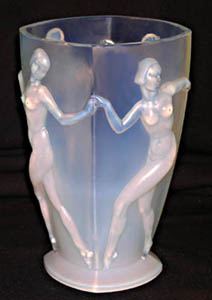

World Distributor of Sabino " Art deco " Opalescent Crystal Figurines


| Home : Catalog : ART DECO | View Cart : Checkout |
| ART DECO-click on picture ART DECO Vase La Ronde is regarded as a pinnacle of the Deco style-the Louvre museum, section of the Arts Deocatifs has a vase La Ronde on display. THE WORKER AS A HERO It is ironic that if the Art Deco period had a defined birthplace it was in Germany. Towards the end of the 19th century, it was Britain which was launching a new style on the world, basically as a reaction against the clutter of the Victorain age. Emerging artists from all over Europe fkocked to London to become part of the arts and crafts revolution started by Williams Morris. Even Rene Lalique and Ernest Sabino fled Paris to study accros the Channel. Eventually, the style came to be called Art Nouveau. It was refreshing and naturalistic change to the backward-looking revivalist themes so popular in the mid-1800. But it was florid, almost excessively abundant and by 1900 began to die away. The initial impetus for change would come from two areas, the United States and Germany. This was, in the history of the modern world, a period of enormous upheaval, political, social and industrial. Many looked at the rapidly changing pace around them with fear. A few looked forward with almost irrepressible optimism. The first machines produced goods which were shoddy-thus the flourishing crafts revival by Williams Morris and others. Hand made goods were superior goods. The uniqualled American architect and stylist, Frank Lloyd Wright, was one of those who dissented loudly. He predicted a time when the emerging possibilities of machine mass production would alter every facet of daily life. In Germany and Austria, Wright's ideas fell on fertile grounds. In 1907, the Germans founded the Deutscher Werkbund. Artists, architects, designers and industrialists were invited to work to counter the deeply negative public attitudes towards machines. The Werkbund style applied aesthetic principles to industrial technique. But then the great war intervened. At the end of it, it was France which emerged with the greater property-not in terms of land, but also in the realm of the imagination. By and large, France had not made the most of the industrial revolution. It emerged from the 19th Century still, largely, an agricultural nation. After 1918, the change was dramatic. France demanded glory, and the entire social machinery of its population turned itself to the task. The entire world would incubate during the 1920s and early 1930s. Perhaps no single project epitomises French panache more during this period than the luxury liner NORMANDIE The French wanted their share of rich American tourists and decided to built a floating palace which would bring them direct from New York to Le Havre. No expense was spared. The greatest artisans of the day were commissionned to put the nation's pride and power on display to the world. Sabino, known as a sculptor in glass, designed a magnificent illuminated fountain and lighting glass sconces for the ship's grand foyer. The Normandie steamed her way back and forth accross the Atlantic, a traveling totem of French style, artistry and industry. Not that she lasted long. Launched in 1935, she was seized by the Americans for use as a troup ship after the fall of Paris in mid-1940. While the Normandie fabulous interior was being stripped out to make way for soldiers, the grand ship was sabotaged, and sank at her moorings in New York Harbor. But for a brief and fantastic time, she was a symbol of Deco age-showing what could be achieved when grand art, grand industry and grand vision were married to each other. The heroism of this combination shows up as a recurring theme of the Deco period-nowhere more so than in some Sabino's works. Sabino embraced the Deco style. This is, perhaps, most obvious in a piece like La Ronde, a spectacular, ornemental vase where four modish nude dancers parade in heroic style. It can be seen in the Group of Elephants, or Couple de Pantheres. Note, in particular, the arrogant grace of the panther's heads and the refined power of the stylised, sinevy bodies. This is what sets Art Deco apart from other periods-every substance is given a special style to the point where the most mundane becomes almost mythical. |
 View large image |
| 3701 Main Street
Houston Texas 77002 USA |
|

Please note our new email address: [email protected]
Sabino is a registered trademark of the Sabino Crystal company.